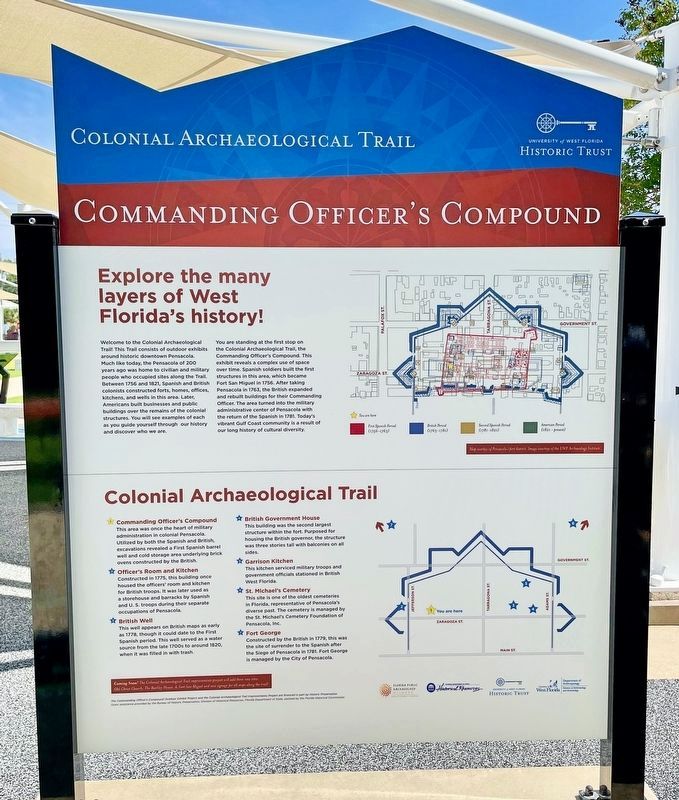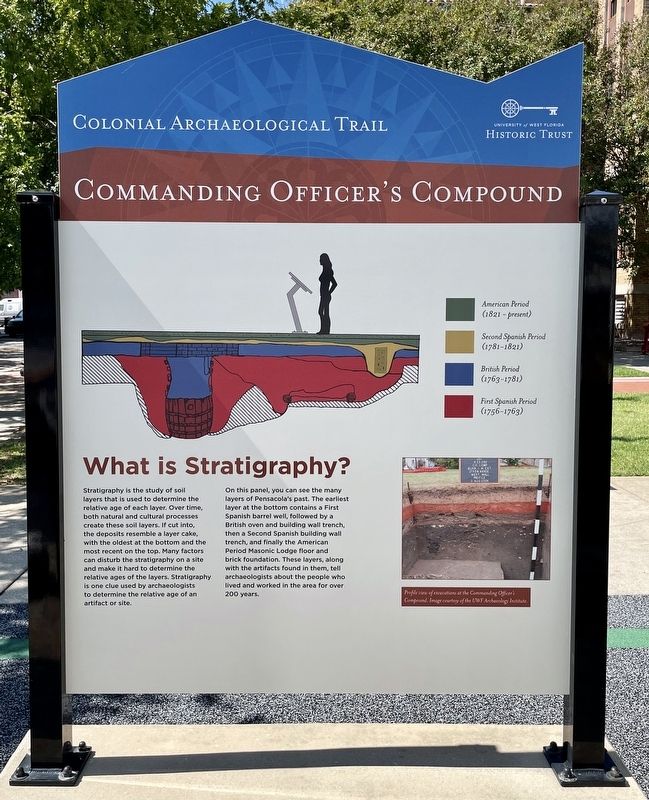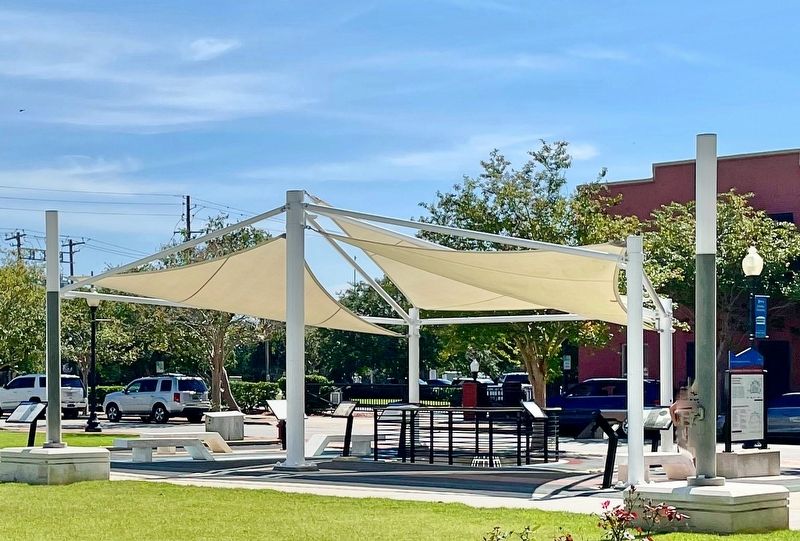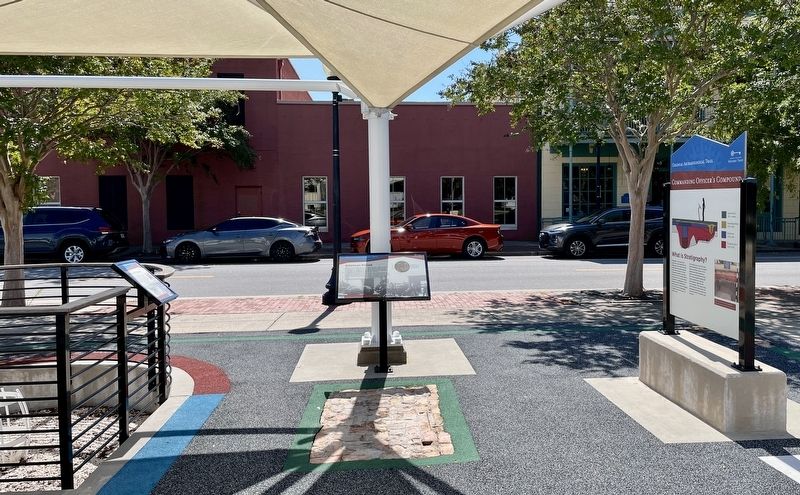Pensacola in Escambia County, Florida — The American South (South Atlantic)
Commanding Officer's Compound
— Colonial Archaeological Trail —
Explore the many layers of West Florida's history!
Welcome to the Colonial Archaeological Trail! This Trail consists of outdoor exhibits around historic downtown Pensacola. Much like today, the Pensacola of 200 years ago was home to civilian and military people who occupied sites along the Trail. Between 1756 and 1821, Spanish and British colonists constructed forts, homes, offices, kitchens, and wells in this area. Later, Americans built businesses and public buildings over the remains of the colonial structures. You will see examples of each as you guide yourself through our history and discover who we are.
You are standing at the first stop on the Colonial Archaeological Trail, the Commanding Officer's Compound. This exhibit reveals a complex use of space over time. Spanish soldiers built the first structures in this area, which became Fort San Miguel in 1756. After taking Pensacola in 1763, the British expanded and rebuilt buildings for their commanding Officer. The area turned into the military administrative center of Pensacola with the return of the Spanish in 1781. Today's vibrant Gulf Coast community is a result of our long history of cultural diversity.
Colonial Archaeological Trail
★ Commanding Officer's Compound
This area was once the heart of military administration in colonial Pensacola. Utilized by both the Spanish and British, excavations revealed a First Spanish barrel well and cold storage area underlying brick ovens constructed by the British.
★ Officer's Room and Kitchen
Constructed in 1775, this building once housed the officers' room and kitchen for British troops. It was later used as a storehouse and barracks by Spanish and U. S. troops during their separate occupations of Pensacola.
★ British Well
This well appears on British maps as early as 1778, though it could date to the First Spanish period. This well served as a water source from the late 1700s to around 1820, when it was filled in with trash.
★ British Government House
This building was the second largest structure within the fort. Purposed for housing the British governor, the structure was three stories tall with balconies on all sides.
★ Garrison Kitchen
This kitchen serviced military troops and government officials stationed in British West Florida.
★ St. Michael's Cemetery
This site is one of the oldest cemeteries in Florida, representative of Pensacola's diverse past. The cemetery is managed by the St. Michael's Cemetery Foundation of Pensacola, Inc.
★ Fort George
Constructed by the British in 1779, this was the site of surrender to the Spanish after the Siege of Pensacola in 1781. Fort George is managed by the City of Pensacola.
Reverse
What is Stratigraphy
Stratigraphy is the study of soil layers that is used to determine the relative age of each layer. Over time, both natural and cultural processes create these soil layers. If cut into, the deposits resemble a layer cake, with the oldest at the bottom and the most recent on the top. Many factors can disturb the stratigraphy on a site and make it hard to determine the relative ages of the layers. Stratigraphy is one clue used by archaeologists to determine the relative age of an artifact or site.
On this panel, you can see the many layers of Pensacola's past. The earliest layer at the bottom contains a First Spanish barrel well, followed by a British oven and building wall trench, then a Second Spanish building wall trench, and finally the American Period Masonic Lodge floor and brick foundation. These layers, along with the artifacts found in them, tell archaeologists about the people who lived and worked in the area for over 200 years.
Profile view of excavations at the Commanding Officer's Compound. Image courtesy of the UWF Archaeology Institute.
Erected by University of West Florida Historic Trust.
Topics. This historical marker is listed in these topic lists: Anthropology & Archaeology • Colonial Era. A significant historical year for this entry is 1756.
Location. 30° 24.516′ N, 87° 12.763′ W. Marker is in Pensacola, Florida, in Escambia County. Marker is on Zaragoza Street west of South Adams Street, on the right when traveling west. Located in the Museum Plaza behind the Pensacola Museum of History. Touch for map. Marker is in this post office area: Pensacola FL 32502, United States of America. Touch for directions.
Other nearby markers. At least 8 other markers are within walking distance of this marker. American Period (here, next to this marker); Archaeology in Pensacola (here, next to this marker); Wells and Cellars (here, next to this marker); First Spanish Period (a few steps from this marker); Colonial Cooking (a few steps from this marker); Second Spanish Period (a few steps from this marker); Stop and Smell the Roses (a few steps from this marker); British Period (a few steps from this marker). Touch for a list and map of all markers in Pensacola.
Regarding Commanding Officer's Compound. The Colonial Archaeological Trail is a collection of outdoor exhibits relating the Spanish, British, and American occupations of Pensacola. This interpretive trail highlights the rich deposits of colonial history and archaeology in the heart of downtown Pensacola.
Credits. This page was last revised on October 11, 2021. It was originally submitted on October 11, 2021, by Mark Hilton of Montgomery, Alabama. This page has been viewed 147 times since then and 13 times this year. Photos: 1, 2, 3, 4. submitted on October 11, 2021, by Mark Hilton of Montgomery, Alabama.



